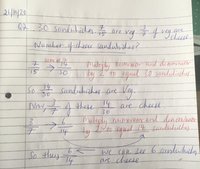Hi All,
My first post, so apologies if any errors made.
I have a question about fractions. It's age 12-13 maths level, I'm from the UK and this is just me doing maths for personal development
It's Q2 I'm stuck on. I managed Q1 fine.
The way Q2 is worded I don't understand. Any help would be greatly appreciated.

Thank you!
My first post, so apologies if any errors made.
I have a question about fractions. It's age 12-13 maths level, I'm from the UK and this is just me doing maths for personal development
It's Q2 I'm stuck on. I managed Q1 fine.
The way Q2 is worded I don't understand. Any help would be greatly appreciated.

Thank you!

